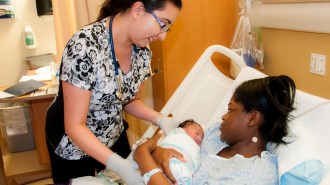Women of childbearing age still aren’t getting enough folic acid
Roughly three in four miss the mark
ANAHEIM Women of childbearing age are supposed to consume at least 400 micrograms of folic acid daily. This blanket prescription is designed to head off a risk of neural tube defects, a class of potentially devastating birth defects. A government study now finds that the vast majority of these women fall short of the mark. Nationally, the average intake is 40 percent below the recommended minimum.
For the past 12 years, federal law has mandated that all enriched grain products in the United States be fortified with 140 μg of folic acid, a B-vitamin, per 100 grams. The rule was intended to help women – especially those who might not realize they were pregnant – meet the daily folic-acid minimum that’s recommended by the U.S. Public Health Service and Institute of Medicine.
Sarah Tinker and her colleagues with the National Center on Birth Defects and Developmental Disabilities (part of the Centers for Disease Control and Prevention) now report that despite this fortification, fewer than 24 percent of women in age groups most likely to get pregnant are meeting their folic acid quota.
Tinker’s team uncovered the depressing stat by sifting through data from a dietary survey administered to 2,617 nonpregnant women between the ages of 15 and 44. All had participated in the 2003 to 2006 National Health and Nutrition Examination Survey, a periodic, federal snapshot of what’s designed to be a statistically representative random cross-section of America.
How few women met the mark varied with age – from a low of 15.5 percent in women 24 and under, to a high of 28.2 percent in women 35 and older. Adequate folic acid intake varied even more dramatically with ethnicity – from a low of 9 percent in non-Hispanic blacks to an anemic high of 30 percent in whites.
Fewer than one-in-10 high-school dropouts met the minimum. The average rose to a little over 16 percent for women with a high-school degree or GED. Even a little college or education beyond high school boosted to 33 percent the likelihood that a woman would be getting enough of the B-vitamin.
But the biggest factor affecting intake was whether a woman regularly took a supplement containing folic acid. Almost three quarters of those who did got at least the minimum daily allowance. Most got more than that. Among women not taking such vitamin supplements, those most likely to regularly meet the folic acid minimum did so by regularly downing fortified breakfast cereals. Indeed, the researchers note, the folic-acid status of American women would be even more abysmal than it already is if it weren’t for the mandatory fortification of cereals, breads and pasta.
The new data were reported April 25 at the annual meeting of the American Society of Nutrition. The meeting is being held under the aegis of Experimental Biology 2010, an umbrella conference sponsored by ASN and five other biomedical research societies (and this year included another 17 guest societies). The data by Tinker’s group are also slated to appear in the May American Journal of Preventive Medicine.







